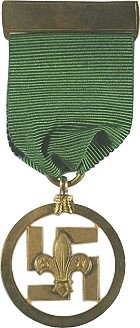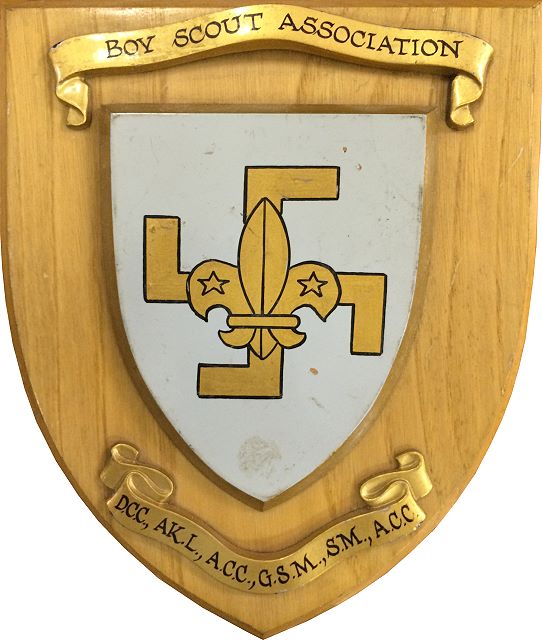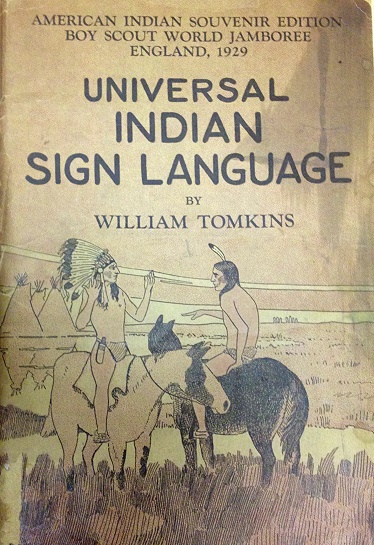 Swastika Question
Swastika Question
 When
one first sees a swastika and a scout symbol, often the first thing
that comes to mind is the question; did scouting support the Nazi
movement? The answer is, no. The swastika symbols have an
extensive history and some have been used for at least 5,000 years.
When
one first sees a swastika and a scout symbol, often the first thing
that comes to mind is the question; did scouting support the Nazi
movement? The answer is, no. The swastika symbols have an
extensive history and some have been used for at least 5,000 years.
The Origin of the Swastika Emblem in Scouting
From What Scouts Can Do - More Yarns — Baden-Powell, 1921; the full text of which can be found on the Pine Tree Web Site:
 "…
as you know from the account of the Swastika Thanks Badge which I have
given to you in Scouting for Boys, the symbol was used in almost every
part of the world in ancient days and therefore has various meanings
given to it.
"…
as you know from the account of the Swastika Thanks Badge which I have
given to you in Scouting for Boys, the symbol was used in almost every
part of the world in ancient days and therefore has various meanings
given to it.
"Anyway, whatever the origin was,
the Swastika now stands for the badge of fellowship among Scouts all
over the world, and when anyone has done a kindness to a Scout it is
their privilege to present him or her with this token of their
gratitude, which makes him a sort of member of the Brotherhood, and
entitles him to the help of any other Scout at any time and at any
place.
"I want specially to remind Scouts
to keep their eyes open and never fail to spot anyone wearing this
badge. It is their duty then to go up to such a person, make the
scout sign, and ask if they can be of service to the wearer."
Robert Baden-Powell
The word of Swastika in Sanskrit is composed of two
words, "Su" (good) and "Asati" (to exists) which means "May good
prevail." Therefore, it also represents happiness, and is often
displayed at celebrations, cultural and religious ceremonies, and at
weddings or festivals of the Indian tradition. The Swastika also
is a symbol of auspiciousness, peace and prosperity.
The swastika was also a widely used Native American
symbol. It was used by many southwestern tribes, most notably the
Navajo. Among different tribes the swastika carried various
meanings. To the Hopi it represented the wandering Hopi clans; to
the Navajo it represented a whirling log, a sacred image representing a
legend that was used in healing rituals.
The Use of the Symbol on the Scouts' Thanks Badge by Colin 'Johnny' Walker
(the original web page from Scouting Milestones is no longer available, but I have retrieved it from archives and am sharing part of it in the frame below)

I have been corresponding with Peter Ford, a UK Scout Association Heritage Research Assistant, and he has provided the 46 page "A guide to the Medals and Awards of The Scout Association."
Pages 41-44 have thanks badges; the guide is very interesting. He
has also provided me images of Thanks Badges which you can see
below. Peter let me know that "The official thanks badge was
registered by James Kyle (HQ Secretary) on 24 Aug 1910."
 An interesting swastika image was sent to me by the Rover Adviser, Phillip Jones, from the 1st
Dulwich Hill/Marrickville Scout Group (Dame Dixson's Own) in Sydney,
Australia which you can see to the left. The writing underneath
the swastika reads: "This Swastika was presented to the late Dame Emma Elizabeth Dixson (biographical link) by
the Chief Scout - Sir Robert Baden Powell in 1908. It was one of
the first three gold Scout emblems to be made for the Chief Scout.
Of the two remaining, he kept one himself, the other he gave to Mrs.
Christian Thornett (biographical link)."
The scout group in Sydney says the gold swastika was presented to Dame
Dixson in 1908 but in discussions with Colin Walker, these were likely
privately made for the Chief Scout; not something from the UK national
scout office which did not occur until 1911. To the best of my
knowledge, in the first few years all Thanks Badges were privately made.
An interesting swastika image was sent to me by the Rover Adviser, Phillip Jones, from the 1st
Dulwich Hill/Marrickville Scout Group (Dame Dixson's Own) in Sydney,
Australia which you can see to the left. The writing underneath
the swastika reads: "This Swastika was presented to the late Dame Emma Elizabeth Dixson (biographical link) by
the Chief Scout - Sir Robert Baden Powell in 1908. It was one of
the first three gold Scout emblems to be made for the Chief Scout.
Of the two remaining, he kept one himself, the other he gave to Mrs.
Christian Thornett (biographical link)."
The scout group in Sydney says the gold swastika was presented to Dame
Dixson in 1908 but in discussions with Colin Walker, these were likely
privately made for the Chief Scout; not something from the UK national
scout office which did not occur until 1911. To the best of my
knowledge, in the first few years all Thanks Badges were privately made.
 For good viewing of the various Thanks Badges, visit www.scoutcollecting.co.uk/ssshop4-badges-leaders-service__amp__good_service315-thanks_badges.html. Also, some early Thanks Badges can be viewed by visiting sites.google.com/site/preaprscoutbadge/1910s-uniform-badge-and-epaulettes.
For good viewing of the various Thanks Badges, visit www.scoutcollecting.co.uk/ssshop4-badges-leaders-service__amp__good_service315-thanks_badges.html. Also, some early Thanks Badges can be viewed by visiting sites.google.com/site/preaprscoutbadge/1910s-uniform-badge-and-epaulettes.
The Thanks Badge has been used in all Commonwealth
countries. In 1933 in South Africa, the Colored Division of the
Boy Scout Association was formed and they chose to be known as Pathfinders.
To meet their requirements, a new Thanks Badge, a Pathfinder Badge on a
swastika, was introduced to be used specifically by the Pathfinder
Section of Scouting. This badge was issued between 1933 and 1939.

 The Girl Guides and Girl Scouts have used a Thanks Badge but the symbol they used was not a swastika.
The Girl Guides and Girl Scouts have used a Thanks Badge but the symbol they used was not a swastika.
I have come into possession of what I will call a
"Thanks Charm." It used the fleur-de-lis of the Thanks Badge
beginning in 1923 and the British Medal of Merit. What is
interesting is that the swastika is rotated 45° and reversed from a
normal Thanks Badge. It has a 9ct mark on one of the legs of the
swastika. It is my understanding that the gold used in Thanks
Badges was 18ct gold but I have more recently learned that there are
some 9ct badges. Also, only the swastika looks to be gold.
This Thanks Charm looks to be fabricated from the fleur-de-lis from a type-6 Thanks Badge as it looks to be exactly the same design and a swastika. The diameter of the Thanks Charm is 29mm. I bought it from an eBayer from Bulgaria.
 This Thanks badge is reported to have been "made on behalf of the 1st
Kelburn Scout Troop in Wellington and presented to their Scoutmaster N
Robertson on occasion of his departure for the war. He had been
drafted into the Wellington Rigles Regiment and left for Glasgow in
Nopvember, 1917." This information is from the New Zealand Museums
website - www.nzmuseums.co.nz/collections/3087/objects/517049/1917-kelburn-scouts-thank-you-badge.
This Thanks badge is reported to have been "made on behalf of the 1st
Kelburn Scout Troop in Wellington and presented to their Scoutmaster N
Robertson on occasion of his departure for the war. He had been
drafted into the Wellington Rigles Regiment and left for Glasgow in
Nopvember, 1917." This information is from the New Zealand Museums
website - www.nzmuseums.co.nz/collections/3087/objects/517049/1917-kelburn-scouts-thank-you-badge.
The problem with the 1917 date, is that this is a type-6 fleur-de-lis which was not used until 1923. The link above for good viewing of the various Thanks Badges
provided me the information about the date. Another interesting
aspect of this pin is that it used a 45° rotated swastika. This is
another part of interesting history on this subject.
 The Medal of Merit in Great Britain and the Colonies
The Medal of Merit in Great Britain and the Colonies
This medal with Boy Scout symbol, swastika and green
silk ribbon was the third version of the Medal of Merit. It was
designed by Baden-Powell in 1928 and the design continued though
1934. During the 1930's, letters of protest were sent to Scout
Headquarters from British Scouters who had traveled abroad. The
letters requested a change of design for the Thanks Badge and the Medal
of Merit. The response was that any medal with a swastika design
could be returned for a new design issued after 1934.
The Scout Association (UK) Heritage Collection were nice enough to share with me a copy of a letter written by The Council of Jewish Scouters written in April, 1933 asking that the "Swastika" be removed from the Scout Movement.

Swastika Badges in France
The Swastika badge was awarded in thanks to adult
leaders after many years of service. There were three levels of
this badge: bronze, silver and gold. France has several scout
organizations and each had its variation of the badge. Examples
can be seen at the right. This information was obtained from fr.scoutwiki.org/Svastika. (By using the Chrome browser, you can get an English translation.)
 An
additional Swastika badge from another scout group was added to the web
page referenced above and I have added it to the left.
An
additional Swastika badge from another scout group was added to the web
page referenced above and I have added it to the left.
 Estonian 1930-40 Boy Scouts Merit Award
Estonian 1930-40 Boy Scouts Merit Award
I did find a early scout badge from Estonia labeled "Estonia Scouts District Swastika Badge 2nd Class." Upon further research, I belive this is a "Estonian 1930-40 Boy Scouts Merit Award." The award from Estonia can be found on this page www.emedals.com/europe/estonia/medals/an-estonian-1930-40-boy-scouts-merit-award-eu6442.
 Czechoslovak Scouting Award.
Czechoslovak Scouting Award.
 The recipient of this award was a Senior Greek Boy Scout leader. You can read more at this link, svasticross.blogspot.com/2010/11/swastika-scout-medal.html.
The recipient of this award was a Senior Greek Boy Scout leader. You can read more at this link, svasticross.blogspot.com/2010/11/swastika-scout-medal.html.
Las Vegas International Scouting Museum
The Museum is the home of the World Scout Bureau
Memorabilia Collection. One of the items they received in 2003 was
the plaque to the right. This plaque was obviously presented to
the World Scout Bureau in the late 1920's or early 1930's from the
British Boy Scout Association.
The Swastika and BSA

 BSA
did not develop a Thanks Badge and the only use of the swastika as a
pin that was worn by the National Executive Board from 1910 to
1919. However, BSA did use the swastika on several books that I
have been able to identify. The spine of the The Scout's Handy Book in 1913 and the back cover of the Universal Indian Sign Language
produced for the 1929 World Jamboree. As I previously
mentioned, the swastika was a widely used Native American symbol
but interestingly, there is no reference to the symbol in the World
Jamboree book.
BSA
did not develop a Thanks Badge and the only use of the swastika as a
pin that was worn by the National Executive Board from 1910 to
1919. However, BSA did use the swastika on several books that I
have been able to identify. The spine of the The Scout's Handy Book in 1913 and the back cover of the Universal Indian Sign Language
produced for the 1929 World Jamboree. As I previously
mentioned, the swastika was a widely used Native American symbol
but interestingly, there is no reference to the symbol in the World
Jamboree book.


 J.
Michael Clinch, who is working on a compilation of BSA council and OA
lodge merger histories, sent me the below additional information:
J.
Michael Clinch, who is working on a compilation of BSA council and OA
lodge merger histories, sent me the below additional information:
The Piankeshaw Council #739, headquartered in Danville
(Illinois) was founded in 1926. A regional non-OA honor society,
the Tribe of Gimogash was active in this council from 1918 until 1930,
when it was replaced with Swastika Lodge (55), whose totem was the
thunderbird. The lodge changed its name in 1935 to the Waukheon
Lodge (55), possibly due to Nazi Germany's appropriation of the ancient
swastika symbol. The lodge totem and the translation of its name
was "thunderbird."
In most cases by 1935, the swastika was not being used in
scouting but I did find the image to the right which referred to the
Comanche Trail Council Indian Camp at the 1937 National Scout Jamboree
on wikipedia which had been uploaded by J. G. Howes.
Another reference that has come to my attention is listed
under Scout Honor Societies on the US Scout Service Project web site;
Order of the White Swastika. That web page is www.usscouts.org/honorsociety/orderwhiteswas.asp. The web page makes reference to a Sports Illustrated
article that is no longer available but I have located the interesting
article in archives and am sharing it in the frame below.
Excelsior Shoe Company Associates their Advertising with Boy Scouts

 Before
I share the advertising of the Excelsior Shoe Co., I have to share that
it was the Excelsior tokens that got me focused on the subject of
Swastikas in Scouting. I noticed that there was a common reverse
of many advertising tokens between the years 1908 and 1935 which I now
realize are the same years as the Thanks Badges using the swastika from
the UK and the Commonwealth. The descriptions and links to these
tokens begin at www.sageventure.com/coins/tokens.html.
Before
I share the advertising of the Excelsior Shoe Co., I have to share that
it was the Excelsior tokens that got me focused on the subject of
Swastikas in Scouting. I noticed that there was a common reverse
of many advertising tokens between the years 1908 and 1935 which I now
realize are the same years as the Thanks Badges using the swastika from
the UK and the Commonwealth. The descriptions and links to these
tokens begin at www.sageventure.com/coins/tokens.html.

 The
Excelsior Shoe Company took advantage of the opportunity to associate
their advertising with the new Boy Scout movement that began in
1910. They created a "Boy Scout" shoe, and issued commemorative
tokens between July 1910 and January 1914. You can learn about the
classification and get links to these tokens at www.sageventure.com/coins/scout.html.
The
Excelsior Shoe Company took advantage of the opportunity to associate
their advertising with the new Boy Scout movement that began in
1910. They created a "Boy Scout" shoe, and issued commemorative
tokens between July 1910 and January 1914. You can learn about the
classification and get links to these tokens at www.sageventure.com/coins/scout.html.
When a scout bought a new pair of shoes from Excelsior, he got
the token to the left with them. It was holed at the top
center. These tokens were made of copper. When the
scoutmaster could prove that everyone in his troop had bought shoes, he
received the same token but in silver.
An interesting article on similar tokens with swastikas, titled Death of an Icon, Swastikas on Jewish tokens once common as 'Good Luck' charms by Steven H. Kaplan was written for The Shekel,
volume 47, no. 1, January February 2014. The article used many of
the tokens from my website for which I was acknowledged. I have
made a pdf out of Death of an Icon as a reference for others.
An Inglorious End
After World War One (1914-1918) a new German political party,
the National Socialists, popularly known as the Nazis, led by Adolf
Hitler took possession of the swastika. It was then that the
innocent device was chosen as their Party emblem. Their Black
Swastika (as it was known) was made into a symbol of 'The Vocation to
fight for the Victory of the Aryan Race' which they considered
themselves to be. This became a specific 'Aryan/Nazi' symbol with
an anti-Semitic purport.
 Hitler and his Nazis took over Germany in January 1933 and on the 15th
of September 1935 raised their party flag to Germany's National
Flag. It was under the cover of this flag with the Black Swastika
that the Nazis committed their crimes against humanity. Although
the Black Swastika is rotated 45° and as opposed to the traditional
swastika which displays it in a "square" configuration, they so much
discredited and soiled the swastika that, when they finally disappeared
in May 1945, the emblem could no longer be used for anything else.
Hitler and his Nazis took over Germany in January 1933 and on the 15th
of September 1935 raised their party flag to Germany's National
Flag. It was under the cover of this flag with the Black Swastika
that the Nazis committed their crimes against humanity. Although
the Black Swastika is rotated 45° and as opposed to the traditional
swastika which displays it in a "square" configuration, they so much
discredited and soiled the swastika that, when they finally disappeared
in May 1945, the emblem could no longer be used for anything else.
Information compiled by Craig Murray
Another interesting article on swastikas - www.worldglobetrotters.com/Links/Swastika/swastika.htm